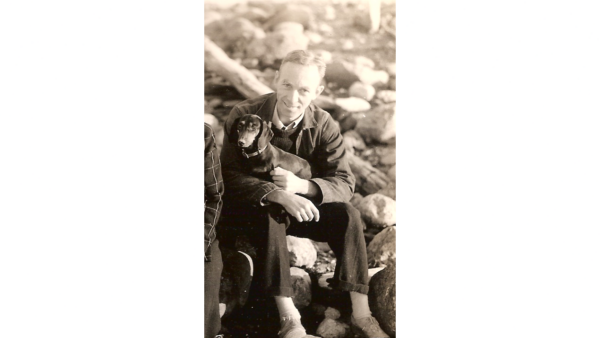


Most everyone has experienced nostalgia at some point in their lives, whether it be a longing for friends, family, or some fleeting moment in time that sparks positive reflection and emotion. The reflection and emotions associated with nostalgia, most often positive, shade the details of events into a soft, ruddy glow.
This idea is central to E.B. White’s short story “Once More to the Lake” published in Harper’s Magazine in 1941. It employs nostalgia and memory as a narrative conduit for details and imagery of a man on a visit to a childhood vacation spot. It is a heartfelt and beautiful rumination on the past, the flowing of time, and the circular nature of aging itself.
CC BY-SA 3.0)
The bulk of the story is told through basic descriptions of locations and activities at a small lake in Maine where the narrator spent several summer holidays with his family. A powerful motif of White’s tale focuses on the narrator’s subjective recollections of places, people, and activities he’d once done as a child. He takes his son fishing in a rowboat, eating at a local farmhouse restaurant, and trekking through trails in the woods. These scenes are utilized to illustrate both the passage of time and how the human psyche processes memory through deeply attached emotion.
Early into the story, the narrator comments that “It is strange how much you can remember a place like that once you let your mind return into the grooves which lead back. You remember one thing, and that suddenly reminds you of another thing.”
The structure and pacing of “Once More to the Lake” progresses in this exact manner. As the narrator encounters one memory after another, it pulls the narrative and audience along for the ride. Memory and emotions combine in seemingly trivial setting details to reach a deep climactic epiphany on the nature of aging and time.
At first, the reader is given small general details about the narrator’s son, his past at the lake with his own father, and reoccurrences of the natural setting that seemed never to have changed since his youth.
There’s a moment where the man and his son are fishing and a dragonfly lands idly on the fishing pole. This seemingly innocuous occurrence creates a moment of reflection for the narrator, and he comments that “It was the arrival of this fly that convinced me beyond any doubt that everything was as it had always been, that the years were a mirage and there had been no years.” Nature at the lake all seemed to be—for the narrator—as it always once was, yet as the narrative progresses, subtle hints of differences begin to creep in and move toward a rumination on the circular nature of life.
One morning the narrator hears his young son sneak from his bed and take a kayak down the lake. This is paralleled to a similar childhood memory of sneaking away, which forces him to confront the realization that “he was I, and therefore, by simple transposition, I was my father.”
After this, the tale begins to reveal more and more details that the narrator remembers being the same, only there are now slight differences. He comments that the waitresses at the family diner were the same age as they’d always been, only now, their hair was washed and clean because they were mimicking movie stars they’d seen. The once ten-mile journey by wagon from the train station to the cabin that built up childhood excitement now was traversed in a car and only took a few short minutes, disallowing for much sustained anticipation.
All these seemingly mundane details take on more importance in illustrating the connection between positive emotion and nostalgia. It is also the catalyst for the narrative’s epiphany in that memory and nostalgia have a way of suspending images and emotions while shielding us from the inevitable foreword march of time.
Author Matthew Vollmer sums up the reflective nature of White’s narrative succinctly as “…we’re only here in this life for a little while, and any honest meditation on the passage of time or on nature’s ephemeral splendor must also acknowledge that our own consciousness, however manifold and complex, is but a spark in the light of our universe.”
The story, in the end, is a rumination of mortality, nostalgia, and time. White masterfully casts the climax against a quick moving evening thunderstorm that, once passed, allows his son to swim in the lake during the rain. As the narrator watches his youthful child dash toward the water, he’s suddenly aware of his own mortality and age.
A symbolic passing of the torch from father to son finally occurs in the end, and the audience is made aware of this impactful realization; however, as Vollmer notes in his essay, the beauty and majesty of the writing is what carries this theme and motif.
It is through the mundane of the everyday and the beauty of the surrounding nature that time can be witnessed and felt. In bringing his son to a cherished spot and reliving memories through him, the narrator comes to terms with the movement of time and can brush aside the glossy tint of nostalgia.


